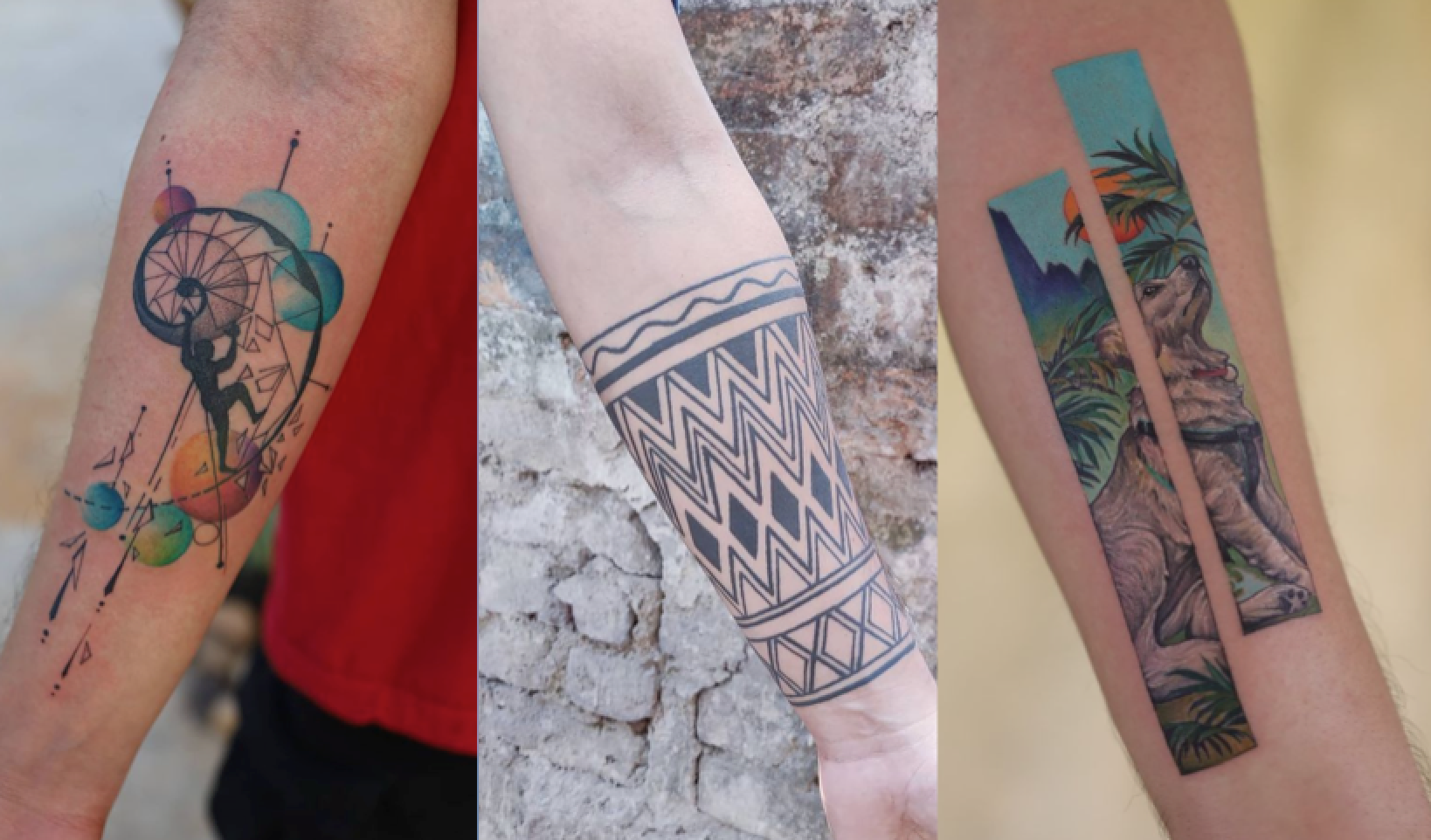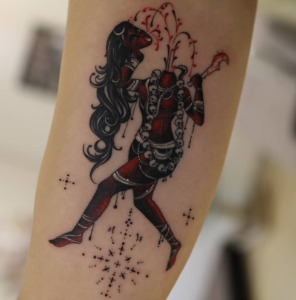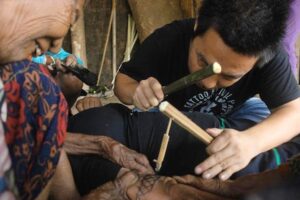The growth of tattoo art: Inking personal stories on a body canvas

Abstract and geometric designs are popular tattoo trends (Photo: left and right: Zaheer Chhatriwala; Middle: Mo Naga)
The art of tattooing has existed since ancient times, used for a variety of reasons ranging from beautification to tribal markings. Facial tattooing was common among many Indian tribes as a mark of being a great warrior or to document their diverse cultures and traditions. It was also fairly popular in several villages and towns where men and women alike got tattoos of names or religious symbols on their arms.
In the last couple of decades however, tattoo art has come into mainstream fashion and culture, using machines and ink to paint masterpieces onto the human body. It has now become a full-fledged commercial industry, largely made popular by films, celebrities, and famous athletes who sport various creative designs. The craze has led to an explosion in popularity and fame of several tattoo artists.
Zaheer Chhatriwala is a Mumbai-based tattoo artist who has worked in the field for 12 years. Having started his career as an apprentice at the popular tattoo studio Kraayonz, he has now made a name for himself in the industry with more than 10,000 Instagram followers and runs his own private studio where he inks custom designs on clients. Rather than the stereotypical bikers or body builders one might expect, he says his clientele is a mixture of both men and women, in the age group of 25 to 50 years.
“Trends come and go, so some things have faded out like arm bands and tribal tattoos, and things like geometrics and mandala designs, henna and colour work are more trendy right now. People are also trying to trust their artist more nowadays, opening up to unique suggestions and ideas and going for more custom work rather than copying off Pinterest or Google Images,” Chhatriwala tells Media India Group.

Chhatriwala’s reimagination of the beautiful, self-decapitated Chinnamasta, who is a form of Hindu goddess Kali
Chhatriwala became fascinated with tattoo art after seeing heavy metal musicians, which inspired him to start his own designs. He now enjoys experimenting with different styles that lean away from realism, mixing elements from abstract patterns and Middle-Eastern prints. Religious or spiritual influences are also popular among Indian clientele, such as Om symbols and gods and goddesses, and artists often put a modern twist on these designs.
Some of Chhatriwala’s favourite custom designs include a tattoo of Lord Shiva riding an Enfield motorbike and a full-back tattoo restoration for a friend, which took him multiple sessions over 2 years.
“I also did a full-colour, Thai-piece Buddhist goddess, with all unique pastel colours, and that was my first time trying to achieve this kind of tone, so it turned out to be one of my best,” he says.
This connect between artist and audience is what sets tattoos apart from other forms of traditional or fine art. Although not taken as seriously by some experts in the art circuit, its permanence means that despite having the same level of intricacy and creative detail as in a painting hung at a gallery, the stakes are much higher.
“I’ve done both tattoos and fine art. A tattoo artist cannot just paint whatever they want; it’s more tailor made. You also can’t afford to make mistakes, so it is far more challenging in some ways. There’s a time limit since you’re dealing with a moving canvas. You cannot take long breaks or slack off in the middle, you have to be on your mental game 110 pc of the time and be able to adapt and improvise, especially in colour tattoos, because everyone’s skin tone is different and advanced colour theory skills come into play,” he says.
Exploring cultural traditions through tribal tattoos
In sharp contrast to Chhatriwala, Mo, a tattoo artist in Manipur, specialises in tribal art Naga tattooing, a fascinating, age-old traditional art form that he is trying to revive. His designs consist of motifs and symbols inspired by nature and tribal peoples’ connection with their surroundings and the animal kingdom. Mo’s Instagram handle, ‘HeadhuntersInk’ is inspired from his warrior ancestors, whose life stories were etched onto their bodies in the form of tattoos.
For tribes such as the fierce Konyak from Nagaland and Baiga tribe of Madhya Pradesh, tattoos constituted a significant part of their heritage, signifying identification, purification, and essential for the passage into the afterlife. However, as Christianity spread in the NorthEast regions of India, these practices were outlawed.
“Naga tattooing stopped many years ago, so it’s not easily visible and it’s not something people talk about very often, and especially back in the days when the Internet was not there, we had absolutely no access to the tattoo culture of our people. So, when I was doing research in college about Naga textiles and handloom, I came across Naga tattoos and the fascination grew. Since then, I’ve been studying and travelling, documenting, trying to revive and reclaim the cultural aesthetics and trying to reframe the narrative which has been many times misrepresented,” Mo tells Media India Group.

Mo, a tattoo artist in Manipur, specialises in tribal art Naga tattooing
The consultation between Mo and the client is the most important part of the journey and can often take hours or even a full day.
“I create ‘neo-Naga’ designs derived from the old expression. The clients who come to me have seen my designs on Instagram but have no idea what they are going to receive. They come to me because they are willing be a part of this movement and I tell them about Naga people, our art, what is appropriation or disrespectful, what are the tattoos they can get and what are the tattoos outsiders cannot get. You are getting something from a different culture on your body for life, so it’s crucial to understand exactly what you’re getting into,” he says.
Mo says that his favourite creations are the tattoos he does on Naga people in the hills, using “pure, traditional techniques” like wild thorns and natural pigments, rather than machine guns or stick and poke.
“It really is a different experience all together; the essence is often lost in a city with noise and pollution, but in the hills, one can truly feel the nature and story of our ancestors,” he adds.
The future of tattoo art
Although the tattooing scene has exploded in recent years, it has largely been limited to the major cities and even there, often has some stigma attached to it.
“A decade ago, things were definitely not as acceptable as now. Bombay is a more progressive city, but some places people do look down or frown upon it, especially in certain corporate jobs or if you’re a doctor, for example,” says Chhatriwala.
Moreover, in the beginning of the Covid-19 pandemic, the industry was hit quite hard, with many smaller artists losing regular clients and not being able to afford rent. Although Mo is busy with his new venture called Tattoo Village, he has seen a dip in customers, especially since most of his clients come from Germany, France, or the UK and have stopped travelling due to the pandemic. Even within the country, business has been slow because professional tattoos are often quite expensive and a luxury expense, which many have not been able to afford after the economic losses of lockdown.
However, the popularity of social media has been essential in helping these artists display their talents to larger audiences. There have also been several tattoo festivals and conventions that have mushroomed across India, such as the Goa Tattoo Festival and Inksoul, which are now easily accessible to enthusiasts and artists who want to explore different styles and cultures.
“All these festivals and collaborations are also slowly bringing back also traditional tattoos and indigenous communities all over the world are trying to revive their art and reclaim their aesthetics, so a lot of these activities and information is being spread through social media and making people more acceptable to tattoo culture,” says Mo.
Tattoo artists are hopeful that the industry will continue to grow as the situation improves and more Indians are exposed to this unique art medium.
“It is not just aesthetics, this art is a form of expression and symbolic script that weaves stories about the client, so every tattoo becomes very special,” says Mo.









